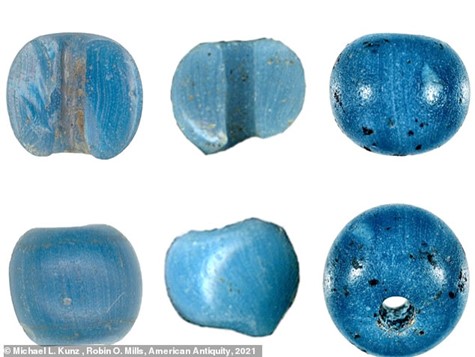Ten antique turquoise Venetian glass beads and the size of a blueberry have traveled approximately 10.500 miles from the present Venice to northwestern Alaska, through Eurasia and the Bering Strait and have survived for centuries in the tundra in three places in northern Alaska.
The pearls were unearthed by Mike Kunz and Robin Mills, archaeologists from the Bureau of Land Management who unraveled the mystery in an article in the magazine "American Antiquity".

The place of the discovery is located in an area crossed by ancient trade routes, frequented by generations of Inuit as a seasonal place for caribou hunting and trout fishing.
Archaeologists have been working in those places for years and in the 50s and 60s William Irving of the University of Wisconsin discovered two turquoise pearls, each with a hole in the center.
Kunz and Mills they continued their search and found other pearls near two copper circles (perhaps a pair of earrings) and other metal fragments that could have been part of a necklace or bracelet.
Woven around one of the earrings were plant fibers which were radiocarbon dated which established the plant as a living and widespread plant in the fifteenth century.
Archaeologists have realized that they are faced with an epoch-making story: glass beads have often been found in other archaeological sites in North America, but never west of the Rocky Mountains and never dated to pre-colonial times.

According to their studies and research the pearls would have landed in Alaska between 1440 and 1480, years or decades before Columbus' voyage.
And it is supposed that to get into the wilds of Alaska they would have passed from hand to hand through various trade routes. Traveling along the Silk Road to China and Eastern Siberia: where a merchant will probably have loaded them onto a kayak to land in Alaska after an 80-kilometer open sea journey through the Bering Strait.
This curious news was presented with a study published on the American Antiquity magazine by Michael L. Kunz of the University of Alaska North Museum in Fairbanks and Robin O. Mills of the Bureau of Land Management.
The authors explain that Punyik Point was a stopping point on ancient trade routes from the Bering Sea to the Arctic Ocean, very prosperous for fishing and hunting and for these reasons also very popular.
Furthermore, Venice was an important city in trade with Asia. A growing body of evidence from the Bering Strait region indicates that the movement of non-native materials from northeastern Asia to northwestern Alaska has occurred through indefinite routes since the first millennium AD, if not more.
This variety of Venetian pearls, notes like "Early Blue" and "Ichtucknee Plain", they have also been previously discovered in the Caribbean, the east coast of Central and North America and the eastern Great Lakes region, but those pearls date back to somewhere between 1550 and 1750 AD.
The results showed that “Alaska pearls” are made of soda glass, typical of the Venetian manufacture of the XNUMXth century and later European.
If the mid-XNUMXth century date is correct, pearls are said to be the oldest known European products brought to the New World and the oldest documentation of "drawn" beads, a type of beads previously dated to the XNUMXth century.
The earliest documented example of the presence of European materials in prehistoric sites in the Western Hemisphere as a result of land transport across the Eurasian continent.
Source: Miglioreinvetro.it and ansa.it



